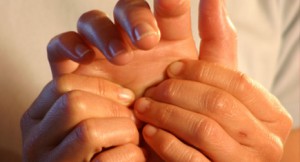Wrapping Your Hands Around Dupuytren’s Disease
 Dupuytren’s disease is an abnormal thickening of tissues in the palm that can change how your hand looks and may make it hard or impossible to use one or more of your fingers. The disease causes tissue under the skin of the palm of the hand to thicken and shorten. This can pull and bend the fingers in toward the palm. Sufferers may not be able to straighten them. The disease progresses slowly and rarely causes pain, but there is no cure. Researchers think it may be a genetic disorder.
Dupuytren’s disease is an abnormal thickening of tissues in the palm that can change how your hand looks and may make it hard or impossible to use one or more of your fingers. The disease causes tissue under the skin of the palm of the hand to thicken and shorten. This can pull and bend the fingers in toward the palm. Sufferers may not be able to straighten them. The disease progresses slowly and rarely causes pain, but there is no cure. Researchers think it may be a genetic disorder.
Those who have Dupuytren’s may first see or feel a small lump in the palm of your hand, usually near where your ring finger and small finger meet. As the disease gets worse, a fibrous cord may develop in the tissue of the palm. The cord may extend to one or more fingers, usually the ring or small finger. The cord may pull your finger toward your palm. This is called Dupuytren’s contracture. At some point a patient may not be able to move your fingers back or flatten your hand on a table. Tasks like putting on gloves, washing your hands, or picking up things become impossible. The disease usually does not cause pain.
How is it treated?
The goal of treatment for Dupuytren’s disease is to keep or restore as much hand function as possible. Dupuytren’s disease often develops slowly. If the tissue between your skin and tendons (palmar fascia) does not thicken to the point that your fingers are bent and cannot be straightened, you may only need to have your palms checked regularly.
- Splints
In the early stages of the disease, you may be able to keep hand function by doing range-of-motion exercises. In some cases, splints are used to try to slow the progress of the disease. - Medicine
If you have increasing disability or pain in your hand(s), your doctor may give you an injection. Lidocaine or corticosteroid has usually been used. But even though medicines may be used to treat symptoms, they do not cure or stop the progression of the disease. A medicine called collagenase is now available. When it is injected, it appears to dissolve some of the tight tissue in the hand. - Surgery
If disability continues to progress, you may choose to have surgery to release the contracture of your fingers. A sustained program of physical therapy and hand exercises may help you regain mobility after surgery. Dupuytren’s disease recurs after surgery nearly half of the time, so another operation may be necessary to keep hand function. - Physical Therapy
Alternative treatments, such as traction devices or exercises, may be used to treat Dupuytren’s disease by restoring and promoting range of motion, strength, and flexibility.
Ongoing Treatment
A sustained physical therapy program—including using splints, stretching, and doing scar tissue massage and hand exercises—may help you regain mobility and prevent complications or recurrences of the disease. Rehabilitation with an occupational therapist is a necessary step in maintaining hand mobility and recovering after surgery. The goals of rehabilitation are to prevent the buildup of fluid, to manage scarring, and to increase your range of motion. Therapy may include wrapping, splinting, massage, stretching, and exercise.
+ Learn about our Hand Therapy Program.
+ Find an Occupational Therapist near you!

